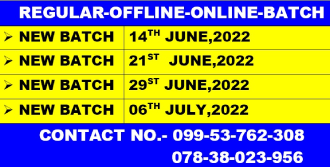A. PROCEDURE TO BE FOLLOWED DURING CONDUCT OF CTET
1. The examination rooms/hall will be opened at 7:30 am for Shift – I and 12.30PM for Shift - II
i.e. 120 minutes before the commencement of test. Candidates should take their seat immediately after opening of the examination hall. If the candidates do not report in time due to any reason i.e. traffic jam, train/bus delay etc, they are likely to miss some of the general instructions to be announced in the Examination Hall.
2. The candidate must show, the Admit Card downloaded from CTET official website for admission in the examination room/hall. A candidate who does not possess the valid Admit Card shall not be permitted for the examination under any circumstances by the Centre Superintendent.
3. A seat indicating roll number will be allocated to each candidate. Candidates should find and occupy their allocated seat only.‟ Any candidate found to have changed room or the seat on his/her own other than allotted, his/her candidature shall be cancelled and no plea would be accepted for it.
4. A candidate who comes after the commencement of the examination shall not be permitted to sit in the examination. The candidates shall report at the Examination Centre at 7:30am for Shift – I and 12.30PM for Shift - II i.e. 120 minutes before the examination.
5. Candidates are not allowed to carry the following items inside the centres :-
a) Any stationery item like textual material (printed or written), bits of papers, Geometry/Pencil Box, Plastic Pouch, Calculator, Scale, Writing Pad, Pen drives, Eraser, Calculator, Log Table, Electronic Pen/scanner, Cardboard etc.
b) Any communication devices like Mobile phones, Bluetooth, Earphones, Microphone, Pager, Health band etc.
c) Any Watch/Wrist watch, Camera, wallet, goggles, handbags Golden ornaments etc.
d) Any other item which could be used for unfair means and for hiding communication devices/gadgets like Camera, Bluetooth device etc.
6. No candidate, without the special permission of the Invigilator concerned, will leave his/her seat or Examination Room until the full duration of the paper is over.
7. Smoking, chewing gutka, spiting etc. in the Examination Hall/Room is strictly prohibited.<
8. Tea, coffee, cold drinks or snacks are not allowed to be taken into the examination rooms during examination hours.
IMPORTANT INSTRUCTIONS PRIOR TO EXAMINATION
9.The test will start exactly at the time mentioned in the Admit Card and an announcement to this effect will be made by the invigilator.
10. During the examination invigilator will check Admit Card of all the candidates to verify the identity of the candidate.
11. The candidate should ensure that the question paper available on the computer is as per his/her opted subject/language indicated in the Admit Card. In case, the subject of question paper is other than his/her opted subject/language, the same may be brought to the notice of the Invigilator concerned.
12.Candidate may approach the Centre Superintendent/Invigilator in the room for any technical assistance, first aid emergency or any other information during the course of examination..
13. In case, a candidate, by furnishing false information, appears in more than one shift/date, his/her candidature will be cancelled and his/her result will not be declared.
14. For those who are unable to appear on the scheduled date of test for any reason, retest shall not be held by the CTET under any circumstances.
15. ROUGH WORK:
All calculations/writing work are to be done only in the Rough Sheet provided at the Test Centre in the examination Room/Hall and on completion of the test, candidates must hand over the Rough Sheets to the Invigilator on duty in the Room/Hall.
16. UNFAIR MEANS:
Candidates shall maintain proper silence and attend their Question Paper only. Any conversation or gesticulation or disturbance in the Examination Room/Hall shall be deemed as mis-behaviour. If a candidate is found using unfair means or impersonating, his/her candidature shall be cancelled and he/she will be liable to be debarred for taking examination either permanently or for a specified period according to the nature of offence.
If any candidate is in possession of any item(s) as mentioned in Para 5 above, his/her candidature for current examination will be cancelled and also liable to be debarred for future examination(s).
17.The announcement about the beginning of the test, half time and closing of test will be made by the invigilator. The candidate must stop marking their responses immediately after the closing of test announcement has been made by invigilator











Stay Up to Date With Whats Happening